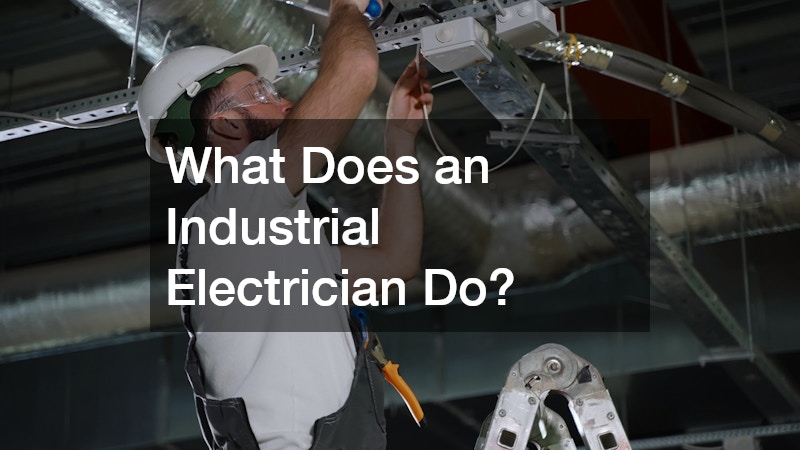What Does an Industrial Electrician Do?
These may include power plants, factories, production facilities, warehouses and large-scale processing sites.
Unlike residential or commercial electricians, industrial experts work with complex and high-voltage systems. Their work demands a strong understanding of electrical theory, safety standards, control systems and industrial machinery. They often collaborate closely with engineers, maintenance technicians and site supervisors to keep equipment running smoothly and efficiently.
Specialised Responsibilities
An industrial wireman’s tasks go well beyond basic wiring or fixture installations. Their day-to-day responsibilities are typically more technical and specialised. These may include:
- Reading blueprints and schematics: Electricians must be proficient in interpreting technical diagrams that guide the installation and repair of equipment and systems.
- Installing electrical systems and components: This includes running conduits, pulling wires and connecting motors, switchboards, sensors and programmable logic controllers (PLCS).
- Maintaining and troubleshooting systems: They regularly inspect machinery for signs of wear, overheating or faults. When breakdowns occur, the electricians identify the cause and repair or replace faulty parts.
- Upgrading systems: As facilities modernise, electricians may be responsible for replacing outdated systems with more energy-efficient or automated technologies.
- Ensuring compliance with safety standards: Industrial sites must meet stringent safety regulations. Electricians play a key role in ensuring that all systems comply with Australian Standards and Work Health and Safety (WHS) requirements.
These tasks require not just technical knowledge but also problem-solving ability and strong attention to detail. A mistake in an industrial setting can lead to serious safety risks or costly downtime.
Tools & Technologies
An Industrial electrician utilises a wide range of tools and technologies. Hand tools such as pliers, wire strippers and multimeters are standard, but they also use more advanced diagnostic and testing equipment. Infrared cameras, oscilloscopes and insulation testers help identify hidden problems before they escalate.
They often work with automation and control systems, including PLCS and human-machine interfaces (HMIS). As more facilities move towards Industry 4.0 and smart manufacturing, the role of the industrial wireman is evolving to include familiarity with robotics, data acquisition systems and Iot (Internet of Things) technologies.
Qualifications & Training
Becoming an electrician in Australia requires a combination of formal education and hands-on training. The most common pathway is through an apprenticeship, typically completed over four years. This includes both on-the-job training and classroom-based learning through a registered training organisation (RTO).
Electricians must hold a valid electrical licence, which is regulated at the state or territory level. Additional certifications may be needed for specialised work, such as confined space entry, working at heights or operating elevated work platforms.
Ongoing professional development is important, particularly in an industry where technologies and standards are constantly changing. Many master electricians pursue further qualifications in automation, renewable energy systems or electrical engineering.
Typical Work Environments
Electricians work in challenging environments. They may be based in factories, power stations, oil refineries or processing plants. Conditions can be noisy, dusty or hot and some sites operate 24/7. Shift work, including night and weekend hours, is common.
In regional or remote areas, such as mining sites, electricians may work on a fly-in-fly-out (FIFO) basis. This type of work can be physically demanding but often comes with higher pay rates and benefits.
Safety is paramount in these environments. Electricians must wear personal protective equipment (PPE), follow strict safety protocols and be constantly aware of their surroundings.
Demand & Career Outlook

The demand for expert electricians remains strong across Australia. As industries expand and adopt more advanced technologies, skilled electricians are needed to install and maintain increasingly complex systems.
The transition to renewable energy and sustainability also presents new opportunities. Industrial technicians are increasingly involved in projects related to solar, wind, battery storage and energy efficiency. Their ability to adapt and upskill will be key to meeting the demands of a low-emissions economy.
There is also significant job stability in this profession. Many industries rely heavily on electrical systems and any disruption can result in lost productivity and revenue. As a result, experienced wiremen are highly valued and often enjoy long-term employment prospects.
An industrial electrician is much more than a tradesperson—they are a critical part of Australia’s industrial backbone. From maintaining essential machinery to ensuring safe and efficient power distribution, their expertise underpins the productivity and safety of numerous sectors.
As industries modernise and adopt new technologies, the role of the electrician will continue to grow in complexity and importance. For those seeking a challenging, stable and technically rewarding career, it remains one of the most dynamic trades in the country.




